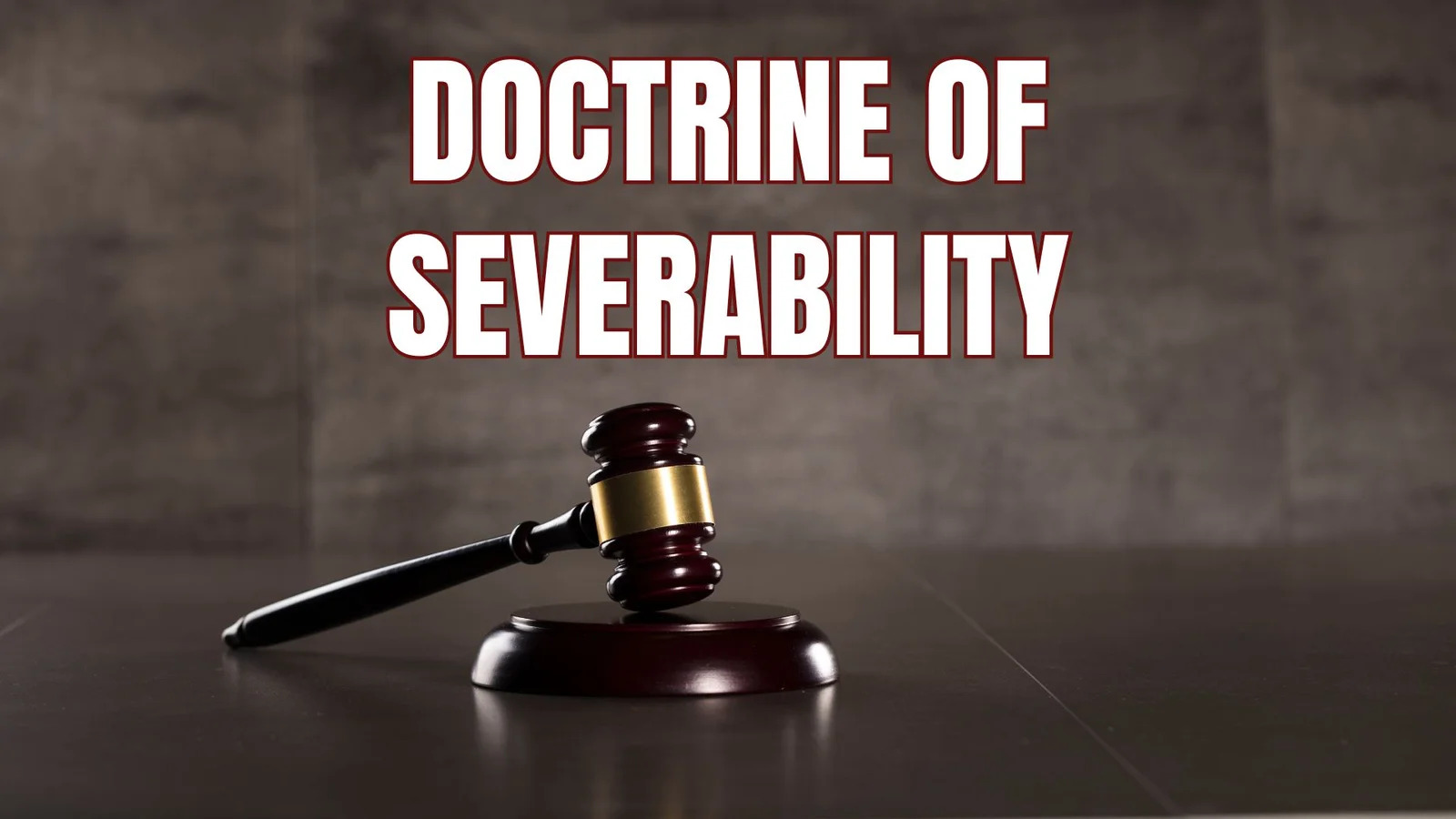View News
Role-of-Severability-in-Constitutional-Law

Role of Severability in Constitutional Law
~Sura Anjana Srimayi
INTRODUCTION
In the constitutional law, some doctrines are like silent yet influential architects whose contributions are imperceptible yet significant in shaping the contours of legislative validity and judicial authority. Among them is the doctrine of severability, which is a root-like, yet not centrally emphasized, principle. Though habitually utilized by constitutional courts globally, its theoretical foundations, subtle use, evolutionist history, and far-reaching implications for legislative drafting and judicial restraint are seldom given the thorough analytical scrutiny they deserve.
The Nature of Severability: Saving the Valid, Cutting Out the Vitiated
The basic nature of the doctrine of severability, or separability, is that where a statute contains part which is unconstitutional, the other constitutional parts may be saved and enforced if they can stand independently and effectuate legislative intent. It is an exercise of judicial surgical nicety, in which courts can remove the "bad" without killing the "good." The alternative, striking down an entire act for the sole reason that one provision is defective, would be a meat-axe approach and could lead to legislative stalemate, public inconvenience, and disservice to the democratic process.
The purpose of severability is multi-faceted. In the first place, it is an exercise of judicial restraint, which avoids the invalidation of statutes that are largely valid in constitution. In the second place, it is an exercise in respecting legislative intent by leaving as much of the legislative action as possible intact, and so preserves the intent of the representative body. Third, it promotes stability and continuity within the law, preventing the disruption that would result if whole legislative frameworks were constantly overturned because of trivial constitutional defects. Lastly, it is a gentle incentive for legislatures to frame laws with modularity and anticipation, forethinking possible constitutional difficulty.
Historical Trajectory and Philosophical Roots
The origin of the doctrine can be found in the early American jurisprudence, specifically in cases such as Dorchy v. Kansas (1924), where Justice Brandeis eloquently enunciated the principle: "A statute bad in part is not necessarily bad in its entirety." Yet, the concept had been applied implicitly earlier. Its evolution is inextricably intertwined with the development of judicial review itself, as courts wrestled with the proper remedy when a statute conflicted with a superior law, i.e., the Constitution.
Philosophically, severability is a precarious balance between deference to legislative prerogative and judicial supremacy in constitutional interpretation. It both recognizes the judiciary's role as the final word on constitutionality while at the same time attempting to limit judicial foray into the legislative sphere. It's an acknowledgment that legislatures, staying within their constitutional authority, are presumed to pass valid legislation. The doctrine is therefore an appreciation of the finer points of the separation of powers, where judicial invalidation is viewed as a tragic necessity, to be exercised with delicacy and restraint.
The Tests of Severability: Determining Legislative Intent and Practical Efficacy
Although the general principle is well established, its application is informed by particular tests that differ subtly between jurisdictions, though on common themes. There are two main considerations:
- Legislative Intent: The overarching test is whether the legislature would have passed the constitutional portion of the statute independently of the unconstitutional portion. This is generally a inferential exercise for the courts since legislatures infrequently include express severability clauses for all provisions. Courts seek to find hints in the statute itself, its history, and the general statutory scheme. If it seems the legislature would not have enacted the valid portion absent the invalid portion, then the entire statute has to fail. This is usually so where the offending provision is so central to the legislative scheme that its invalidity would make the rest of the provisions nugatory or radically change the intention of the law.
- Independent Operation/Workability: Assuming legislative intent is in favor of severability, the surviving constitutional provisions must be independently operable. This requires that once the unconstitutional portion is severed, the balance of provisions remains coherent, comprehensive, and enforceable in accordance with their intended purpose. If severance produces a mutilated, illogical, or unenforceable remainder, the whole statute will probably be invalidated. For example, if a statute prescribes a five-person commission and the appointment of two of the members is unconstitutional, and the other three are incapable of performing the functions of the commission as the legislature conceived, then the whole statute could be struck down.
- Distinct and Separable Scheme: This test probes if the constitutional and unconstitutional provisions form different and distinct schemes. If the invalid portion is so inseparable from the valid portion that it forms one inseparable scheme, then severance is not possible. However, if the provisions involve different topics or can be logically divorced from each other without altering the fundamental purpose, severability is probable.
Inclusion of a "severability clause" in a statute is generally strong evidence of legislative intent. These clauses clearly indicate that should some portion of the act be held unconstitutional, the rest of the act is to remain valid. Though not conclusive (courts still use the substantive tests), they give rise to a strong presumption of severability and indicate the legislature's prudence. But the failure to include such a clause is not necessarily an indication of non-severability; the courts will continue to seek out intent.
Challenges
- Judicial Creativity vs. Restraint: Application of severability usually calls for some judicial creativity in "rewriting" or essentially amending a statute by excising portions. This risks crossing the line between interpretation and legislation, and threatening judicial overreach. Critics warn that wholesale severance has the potential to produce a law that the legislature never actually meant to enact, thus encroaching on the separation of powers. Courts need to be careful lest they be legislating in disguise as they try to save existing law.
- The "Essential Purpose" Conundrum: The determination of the "essential purpose" of a statute, particularly when a central provision is unconstitutional, is extremely subjective. Fundamental to one judge's understanding, another may see it as ancillary. The subjectivity can result in variable application and controversy regarding the appropriate reach of judicial examination into legislative intent.
- Remedial Problems: In certain elaborate statutory systems, striking down an unconstitutional component may leave a "gap" that has to be filled by further legislation. Courts as the remedial organ can only invalidate but not legislate. This may result in a situation of legal uncertainty until the legislature moves, or it may produce an unintended result worse than the original unconstitutional one.
- Comparative Perspectives: Although the rule is widely accepted, its application differs. For example, in some civil law systems, the weight may be more towards the continuity of the legal order, in some cases resulting in wider application of severability. In others, especially where constitutional courts play a powerful supervisory function, legislative intent may be more strictly focused on. Indian Supreme Court, for instance, has applied the doctrine consistently with the main objective of upholding as much of the law as possible, subject to the test of workability and intent, as held in celebrated cases such as A.K. Gopalan v. State of Madras and R.M.D.C. v. Union of India.
- Effect on Legislative Drafting: The presence of the severability doctrine inherently affects legislative drafting. Clever legislative drafters routinely draft statutes in modular form, with separate portions or provisions that are constructed to function independently, or they place express severability clauses in statutes, in order to maximize the chances that their legislative product will pass constitutional muster. This induces a more reflective and constitutionally sensitive legislative process.
CONCLUSION
The doctrine of severability, while all too frequently playing second fiddle in constitutional analysis, is a silent but integral pillar of contemporary constitutional rule. It is a marker of the robustness of constitutional design that makes possible the reasonable resolution of constitutional conflict without destabilizing the whole legislative edifice. By allowing courts to surgically excise unconstitutional portions while leaving the valid intact, it finds a necessary balance between the necessity of constitutional fidelity and legislative stability.
Yet its subtle power requires attentiveness from both the judiciary and the legislature. Courts must use it with principled restraint, Legislatures, for their part, are implicitly nudged to fashion laws with increased precision and foresight, having regard to the possibility of partial invalidation.
In an age where ambiguous law is the norm and constitutional questions are common, knowledge of severability's nuances is more important than ever. It is more than a technical device; it is a high-minded form of judicial statesmanship, a guarantor of democratic intent, and an underappreciated architect that quietly supports the complex framework of a constitutional democracy. By illuminating this frequently underrated doctrine, we are reminded of the flexible and enduring character of constitutional law itself.
"Unlock the Potential of Legal Expertise with LegalMantra.net - Your Trusted Legal Consultancy Partner”
Disclaimer: Every effort has been made to avoid errors or omissions in this material in spite of this, errors may creep in. Any mistake, error or discrepancy noted may be brought to our notice which shall be taken care of in the next edition In no event the author shall be liable for any direct indirect, special or incidental damage resulting from or arising out of or in connection with the use of this information Many sources have been considered including Newspapers, Journals, Bare Acts, Case Materials , Charted Secretary, Research Papers etc

